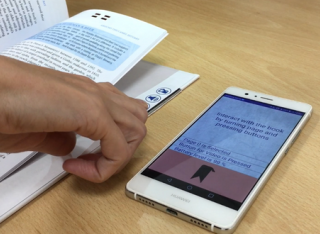
Dr Georgios Bairaktaris
Academic and research departments
Faculty of Engineering and Physical Sciences, Advanced Technology Institute, Digital World Research Centre.About
University roles and responsibilities
- EEE UG Laboratory Demonstrator
News
Publications
In today's digital world, paper's reason of being is challenged. Yet, studies suggest that books and paper-based objects have advantages ranging from the tactile sensation to information retention and indexing. We have developed a hybrid electronic device, the "a-book," that offers access to up-to-date and pertinent multimedia content as part of the ordinary interaction with a typical hardcover book. The device maintains the look and feel of a conventional book and is connected to the web through an adjunct smart device. Here, we provide a technical project summary of the electronic system for book augmentation. We outline the system's functionality and discuss its manufacturability, prospects, and limitations in the context of current and emerging flexible electronics technologies.
A new form of interaction with digital displays is described, using the pages and binding of a physical book as the interface. This leads to a form of augmented book, or a‐book, which can seamlessly trigger multimedia content on a nearby device using embedded light, pressure or touch sensors.
We demonstrate a flexible electronic bookmark designed to facilitate the augmentation of printed content with media-rich, dynamic digital content, thereby extending the utility of ordinary books. The system, produced by the hybrid integration of photosensors, detects the currently open page within a book via gestures that are natural to the book reading experience. Physical cut-outs within the page or high contrast patterns printed in graphical ink define a unique code, which is optically read by the functional bookmark.
Silicon-based digital electronics have evolved over decades through an aggressive scaling process following Moore’s law with increasingly complex device structures. Simultaneously, large-area electronics have continued to rely on the same field-effect transistor structure with minimal evolution. This limitation has resulted in less than ideal circuit designs, with increased complexity to account for shortcomings in material properties and process control. At present, this situation is holding back the development of novel systems required for printed and flexible electronic applications beyond the Internet of Things. In this work we demonstrate the opportunity offered by the source-gated transistor’s unique properties for low-cost, highly functional large-area applications in two extremely compact circuit blocks. Polysilicon common-source amplifiers show 49 dB gain, the highest reported for a twotransistor unipolar circuit. Current mirrors fabricated in polysilicon and InGaZnO have, in addition to excellent current copying performance, the ability to control the temperature dependence (degrees of positive, neutral or negative) of output current solely by choice of relative transistor geometry, giving further flexibility to the design engineer. Application examples are proposed, including local amplification of sensor output for improved signal integrity, as well as temperature-regulated delay stages and timing circuits for homeostatic operation in future wearables. Numerous applications will benefit from these highly competitive compact circuit designs with robust performance, improved energy efficiency and tolerance to geometrical variations: sensor front-ends, temperature sensors, pixel drivers, bias analog blocks and high-gain amplifiers.
Thin-film transistors deliberately comprising rectifying source contacts have attractive properties for sensor and driver circuits: high performance uniformity and geometrical tolerance; superior saturation; and high intrinsic gain. The paper reviews the source-gated and multimodal thin-film transistor configurations, and presents their proposed applications to ultra-compact sensing and data processing circuits. Source-gated transistors with nanoscale tunneling contacts offer an alternative to the Schottky-contact fabrication route, which presents processing challenges. Emerging multimodal transistors overcome limitations of traditional contact-controlled devices and add to the list of useful properties: high gain or constant transconductance by design; immunity to drain voltage variations in floating gate configuration; and a significantly faster response time than source-gated transistors. These devices form the foundation for the design of compact, yet extremely versatile, thin-film circuits for sensing, signal conditioning and signal conversion. Finally, a vision is presented in which the properties of these circuits will be essential to convey seamless user interactivity to physical objects, transforming them into intuitive user interfaces beyond traditional displays screens.
Paper books offer a unique physical feel, which supports the reading experience through enhanced browsing, bookmarking, freeform annotations, memory and reduced eye strain. In contrast, electronic solutions, such as tablets and e-readers, offer interactive links, updatable information, easier content sharing, and efficient collaboration. To combine the best aspects of paper and digital information for reading, we demonstrate two mechanisms for augmenting paper with light sensors that trigger digital links on a nearby smartphone. Light Tags on every page of a book are used in a first demonstration to identify which pages are open. These are replaced with an electronic Magic Bookmark in a second demonstration, avoiding the need to instrument every page.
In today's world of connectivity and automation, novel user interfaces are used to incorporate technology into our lives in a seamless way. Printed electronics provide the tools for making flexible and conformable electronic systems that can augment the functionality of everyday objects. However, compared to conventional, off-the-shelf devices, their performance is insufficient to obtain a functional and robust fully printed system. In this work, we are developing purpose-built photodetectors (PDs) for their use in an augmented paper platform, the Magic Bookmark. The developed PDs exhibit an on/off ratio of 0.2, resulting in a voltage swing of 200 mV, when connected to external circuitry, indicating suitability for the Magic Bookmark within high tolerances due to the readout scheme selected.
The use of physical paper is often preferred due to its unique physical properties that improve various aspects of reading. However, digital media and information are more engaging, diverse, and up to date, thereby challenging the existence of paper in our everyday life. By combining the two types of media in a seamless way, the interactivity of multimedia content can complement the reading experience, maintaining the unique feel of paper books. The current state of the art addressing this application negatively impacts the reading experience and often does not consider the manufacturability and sustainability of the proposed solutions. In this work we are introducing the Magic Bookmark, a technical solution for automatically recognizing the open page of a physical book, to provide seamless augmentation without changing the user’s behavior and experience significantly. Our implementation consists of three alternative solutions, with various degrees of ease of use, manufacturability at scale and reliability of data reading. The optimal realization is found to be a reflective optical readout array, for which we propose routes to implementation that may allow blending the graphical and functional aspects of the augmented book.
Printing techniques have been widely adopted in the fabrication of flexible electronic components. However, its application is still limited in complex control and communication circuitry due to the low performance and low fabrication uniformity amongst printed devices, compared to conventional electronics. Thus, the electronic systems in real-world applications are hybrid integrations of printed and conventional electronics. Here we demonstrate a low-cost, low-complexity, fully-printable flexible photodetector that can withstand over 100 1 mm-radius bending cycles using a simple and scalable two-step fabrication process. The prototypes are implemented in an augmented book system to automatically detect the ambient light through optical apertures on paper of a printed book, and then transmit the information to an adjunct device. This technique demonstrates the utility of low-cost materials and processes for robust large area sensing applications and could act as a gateway to pertinent multimedia information.
Additional publications
Presentations and Other Publications
Exhibition presentation (NovaCentrix):
“Next Generation Paper”, iDTechEx November 2019, Santa Clara, USA
___
Poster presentation:
“Next Generation Paper: A versatile augmented book platform”, InnoLAE January 2020, Cambridge, UK
___
Oral presentation & iZone exhibition:
“Using physical books as interfaces to digital displays”, Display Week August 2020, virtual conference (originally San Francisco, USA).



